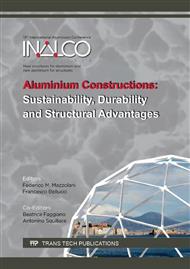[1]
Mazzolani, FM. Structural Applications of Aluminium in Civil Engineering. Structural Engineering International. Vol. 16 (2006). 280-285. ISSN. 1016-8664.
DOI: 10.2749/101686606778995128
Google Scholar
[2]
EN 1999-1-1. Eurocode 9, Design of aluminium structures – Part 1-1: general structural rules, CEN, (2007).
Google Scholar
[3]
Della Corte, G., De Matteis, G., Landolfo, R., Mazzolani FM. Seismic Analysis of MR Steel Frames based on Refined Hysteretic Models of Connections. Journal of Constructional Steel Research. Volume 58, Issue 10, October 2002, Pages 1331–1345.
DOI: 10.1016/s0143-974x(02)00014-7
Google Scholar
[4]
EN 1993-1-8, Eurocode 3, Design of steel structures - Part 1-8: Design of joints, CEN, (2003).
Google Scholar
[5]
Graham, J.D., Sherbourne, A.N., Khabbaz, R.N. Welded Interior Beam to Column Connections. American Institute of Steel Construction (1959), Chicago, Ill.
Google Scholar
[6]
Zoetemeijer, PA. Design method for the tension side of statically loaded bolted beam-to-column connections. Monogr. Heron, 1974. 20(1).
Google Scholar
[7]
Aribert, J.M., Lauchal, A., Nawawy, O.I. Elastic-Plastic Modelization of the Resistance of a Column in the Compression Region. Construction Metallique, No. 2. (1981) (in French).
Google Scholar
[8]
De Matteis, G., Mandara, A., Mazzolani, FM. T-stub aluminium joints: influence of behavioural parameters. Computer and Structures 2000; 78(1–3): 311–27.
DOI: 10.1016/s0045-7949(00)00081-x
Google Scholar
[9]
De Matteis, G., Mazzolani, FM. Behaviour of welded aluminium T-stub connections: experimental analysis and interpretative models. Proceedings of the ASCE structures congress; May (2006).
DOI: 10.1061/40889(201)45
Google Scholar
[10]
De Matteis, G., Brescia, M., Formisano, A., Mazzolani, FM. Behaviour of welded aluminium T-stub joints under monotonic loading", Computer and Structures 87 (2009) 990-1002.
DOI: 10.1016/j.compstruc.2008.04.022
Google Scholar
[11]
De Matteis, G., Naqash, M.T., Brando, G. Effective length of aluminium T-stub connections by parametric analysis., Engineering Structures, 41, 548-561 (2012).
DOI: 10.1016/j.engstruct.2012.03.052
Google Scholar
[12]
Matusiak M. Strength and Ductility of Welded Structures in Aluminium Alloys. Ph.D. thesis (1999), Departement of Structural Engineering. Norwegian University of Science and Technology (NTNU), Trondheim, Norway.
Google Scholar
[13]
De Matteis, G., Sarracco, G., Brando, G., Mazzolani, F.M. Influence of Column Axial Load and Heat Affected Zone on the Strength of Aluminium Column Web in Tension. MDPI-Materials, 7(5), 2014, 3557-3567; doi: 10. 3390/ma7053557.
DOI: 10.3390/ma7053557
Google Scholar
[14]
Brando G., Sarracco, G. De Matteis G. Strength of aluminium column web in tension. Journal of Structural Engineering-ASCE. 141 (7). (2015).
DOI: 10.1061/(asce)st.1943-541x.0001138
Google Scholar


